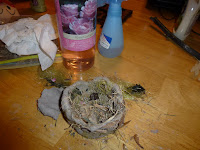(A) is for art: Crazy art/Japanese teacher
According
to the BGFL multiple intelligence test, I am really strong with visual/spatial
and logical intelligence. Not much
behind is a musical intelligence, thus I imagine my dream learning environment as
a space surrounded by visuals in logical order with background
music to make the learning exciting and consistent. I knew
I was a non-traditional student with unique needs, but this sounds a bit more
chaotic than I would like it to be. Oh well,
I am a fit art teacher.
My weakness
is definitely the kinesthetic. I remember when I threw a ball for my fitness
test, my record was about 6 feet (average was 15-20 feet). I did play basketball, at least I can
dribble, was a fast mid distance runner, and I can swim, so my PE grade was not
too terrible... Linguistic and
naturalistic score are just above the kinesthetic intelligence, so I probably am
not too comfortable in these areas either. (which sounds bad as a Foreign
Language teacher! oops.)
With these
strength and weakness in mind, I realize that my teaching style would heavily
rely on visual and bulleted points. My
typical lesson usually are designed with mini activities (15min most) that
keeps students busy, and it also creates a routine. I imagine that my teaching style is not fit
for every student, so I usually pass handout with vocab/concept list so those
who was confused can understand.
(B) Is
for Brilliant Bilingualism.
I feel that most children think
more abstractly. I think this is so because they do not have a concreate mind
yet, thus their thinking process is more fluid like and vague. I feel that this is why they can learn fast
and forget fast. With this idea in mind,
I really like the Dale’s cone of experiences since it focus on a balance between
concrete and abstract experiences. The concrete
experience, the foundation of knowledge by doing, will help student stay
focused on facts, and without them, Newton’s apple may never fall to the ground
in their mind.
Broom’s Revised Taxonomy is a
really good guide for teachers to base a lesson on. The LOTS are the basic
knowledge that students need and HOTS are the thinking skill that they should exercise. However, I personally think the HOTS can
never be evaluated fully within school year. There is definitely not enough time
for students to really create something neither for the teacher to really
understand what students are capable of creating. If you think of how long it took Bill Gates to
create MS-DOS, you may see my points. I do not mean that students should never try
to create something during school year, what I mean is that we need to understand
that students can do more than what they create at school. We often forget to remind them their
capability, and students start to forget about it.
UDL seems to be a great guideline for
learning. It would be great if we can design K-12 curriculum with elementary
focusing on representational experience, middle school for action and
expression, and high school for engagement. Maybe in a way, mathematics education follows
the UDL in K-12, but I think it still lucks student center characteristics. Modern Language education should also follow
the K-12 learning, instead it is often only taught in high-school. Problem with this is that students are stuck
with learning basic concept of the language when they are capable of exercising
much more. Also, they have lost their flexibleness
that would have enabled them to accept new concept easily. I hope this is making sense; I do not have
strong linguistic intelligence. :) :) :)
My theory I would like to highlight
is Operant Conditioning by Skinner. This
follows the idea that practice makes it perfect as reinforcement is the key for
Skinner’s theory. What I like about this
theory is that failure is not a complete failure. Just as game based learning, the
focus is on making it to a goal through reinforcing and correcting; thus the students
should feel comfortable making mistakes. I feel that this theory would only work for
smaller class or technology based independent learning. If we can somehow create an environment of
learning where students are not afraid of making mistake but motivated to
learn, the outcome would be beyond measure. Small children can do this, and we should
learn from them.
Below is my ideal learning environment: visual in logical order with music.








